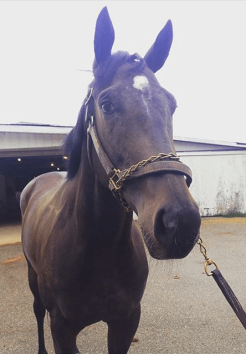Now that I have given you insight into my story, I want to dive into Bailey’s old life in the fast lane.
After doing my research into adopting an off-the-track Thoroughbred and enlisting the aid of my trainer, we set off on a road trip to a small race track near Louisville, Kentucky. A reputable trainer named Amy Paulus was offering countless client horses online and a handful of which caught my eye. We made arrangements to meet and planned to look at around two dozen prospects.
Purchasing an ex-race horse is vastly different than the regular standards of the equine trade. Normally a rider is given the chance to ride the horse, visit them multiple times, and maybe even take them on trial before making one of the biggest investments of their life.
In the racing business there is none of this.
Buying an ex-race horse is a fast paced, high stakes decision because the industry is ruled by the almighty dollar. I was only allowed to see each prospective animal for about five minutes each, watch someone jog them across the barn ail and feel the horse over for any signs of obvious injury.
If you’ve never purchased an ex-race horse, simply imagine buying a used car based on a split second decision.
Crazy right?
We were bombarded with about 30 horses in a span of two hours, allowing a five minute window to say yes or no. Luckily my trainer, Ashley Bailey, is experienced in purchasing an ex-race horse and would give me immediate feedback about the qualities she liked and disliked about each animal.
When we reached the last shed row and there were no more horses left to be seen, all but none of them met the standards I had set. They were clearly talented animals built like Olympic athletes, however their hot tempers constantly flared and many had no basic manners. I was scared to touch a few of them. Some horses would try to bite, strike out with their powerful legs or rear because they were so energetic and I knew these behaviors were almost impossible to fix.
I was disappointed.
Amy then told us about one last filly named I’mfixin’to who was for sale at a small training barn a few miles up the road. With nothing to lose, we made the trek across the state line into Indiana to a facility in Shelbyville. Amy guided us to the filly’s stall and walked her out as she had done so many times earlier that day.

Bailey, previously named I’mfixin’to, the day I met her in July 2016.
This filly was big with broad shoulders, a great physical asset for jumping. Her demeanor was kind and attentive and she stood calmly while I felt her legs and picked out her hooves. It was almost unusual how docile she behaved compared to the hot tempered Thoroughbreds that Amy had showed us at the race track.
Then it was time for the all-important jog.
My trainer took the filly’s lead rope and began to run beside her while I watched her movements. As she circled back, a flock of pigeons flew out behind I’mfixin’to. Any other horse that day would have lost their sanity; however she listened to what was going on behind her, realized the birds were no threat, and continued to jog next to Ashley. This unexpected test of her critical thinking skills sold me in an instant.
Not only was she athletic, she was intelligent.
I never met her owner, but I purchased this filly for $1,300 which was a $198,700 loss of their initial investment. The racing industry isn’t interested in a horse who can think critically, they simply want one that is faster than the rest.
The next day my trainer and I headed home with horse in tow, ready for what ever the future may bring.